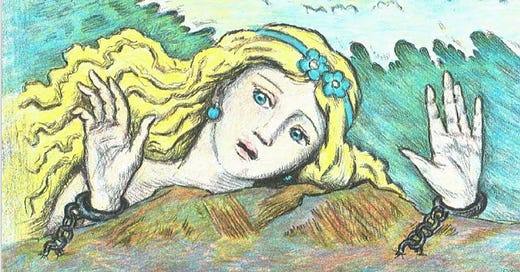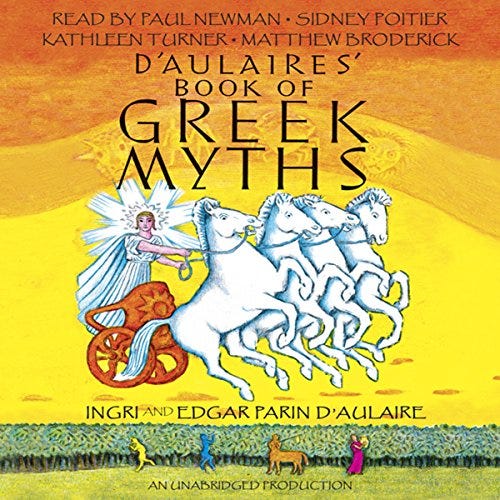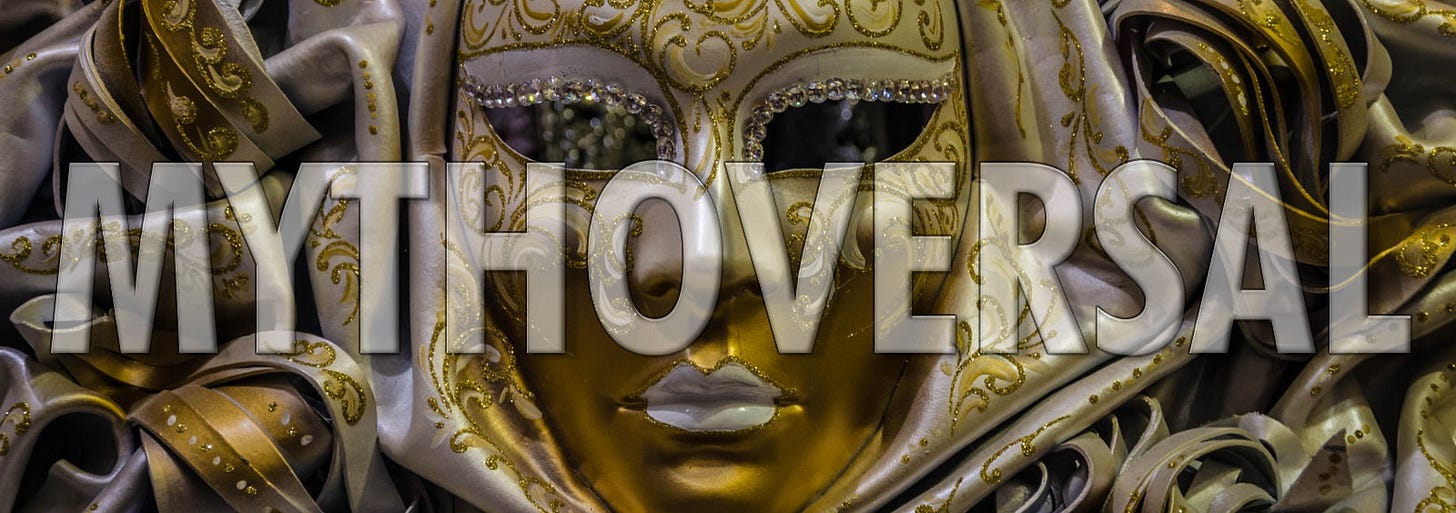Mythic Monday: The Whitewashing of Ethiopians
Representing Ethiopian Characters in Greek Mythology
In a recent post on The Invention of Greek Mythology, D.W. Frauenfelder wrote about the depiction of Ethiopian characters as white in retellings of Greek mythology.
Frauenfelder brings up the specific example of D’Aulaires’ Book of Greek Myths, a children’s book by the Caldecott-winning married couple, Ingri and Edgar D’Aulaire. This book has been popular since it was first published in 1962 and is still widely available. This was the book I read in third grade that introduced me to the stories of Greek mythology and raised many of the questions I’m still struggling to address.
I’m quite nostalgic about this book, but I have to agree that its depiction of Ethiopian characters is…
…not the best.
That milk-skinned blonde maiden in chains is the D’Aulaires’ rendering of Andromeda, an Ethiopian princess who was set out on the rocks by her family to mollify a rampaging sea monster. The monster was slain by the hero Perseus, who brought the rescued princess home as his wife. Together, they founded the city of Mycenae and began a dynasty that included many other legendary figures, including Herakles/Hercules.
In a future article, I will delve into whether the ancient Greek version of Ethiopia was meant to be in Africa, South Asia, or elsewhere. The important thing for now is that all known traditional sources agree that Andromeda was Ethiopian, and that wherever Ethiopia was, the people there had darker skin than the Greeks.
But for some tellers of the tale, even back in ancient times, it was unseemly for the matriarch of a prominent Greek dynasty to have had dark skin, and for Amphitryon, Alcmene, Herakles, Iphicles, Iolas, and Eurystheus, among others, to have had an Ethiopian heritage. So a tradition of whitewashing these characters began early.
Ovid, writing The Heroides in the late 1st Century BC, explicitly describes Andromeda as having dark skin. And while he does compare her to a marble statue in his Metamorphoses, the statues of his day were typically painted in various skin tones. Certainly what Ovid meant to convey was that Andromeda, chained to the rock, wasn’t moving, either out of fear or to avoid attracting the attention of the nearby monster.
In contrast, a work attributed to Heliodorus of Emesa from the 3rd Century AD reflects a different tradition. Heliodorus describes Andromeda as having such purely white skin that black mothers in Africa could bear white children just by thinking about her as they conceived.
Artists from Late Antiquity through the Middle Ages and Rennaisance got a kick out of depicting Andromeda as a naked or revealingly clothed lady chained to a rock. But most of them preferred the obscure account of Heliodorus of Emesa over the more prominent version promoted by Ovid, for some odd reason.
The D’Aulaires were far from the first to whitewash Andromeda and her descendants. But they uncritically received and retransmitted a longstanding tradition of whitewashing to a broad audience and new generations.
The cover to the D’Aulaires’ book depicts Phaëthon, who one day took over the reins from his father, the sun-god Helios. Because Phaëthon was not skilled enough to control the fiery horses, the once light-skinned Ethiopians were forever darkened by the light and heat of the sun-chariot as it steered too close to the ground.
The name “Ethiopia” comes from Greek roots meaning “burn” and “face” for the supposedly burned faces in this story, which assumed whiteness as a default and blackness as a deviation that required a mythic explanation. This topic, also, will be covered in a future article.
Because of the popularity of the D’aulaires’ book, kids from 1962 onward have had blonde Andromeda as their first exposure to the originally dark-skinned character who once brought diversity and inclusion to the mythic works of Ovid.
When I started writing my own versions of these myths, I thought I had a pretty good handle on who Iphicles was. He’s the all-mortal twin brother of a demigod. He’s the firstborn son of Amphitryon, but always seems to have gotten less respect and attention than he deserves. But possibly due to my exposure to the media of my youth, including the D’Aulaires’ book, I initially imagined Iphicles as having light skin and Caucasian features.
As it turns out, Iphicles had two mortal parents of mixed Hellenic and Ethiopian heritage. He is related to Andromeda on both his mother’s and father’s sides. Furthermore, Iphicles grew up in Thebes, a diverse city founded by a Middle Eastern prince, ruled by a noble class that sprouted from dragon teeth, and a pilgrimage destination for the South Asian followers of Dionysus. In a multicultural Thebes, as a descendant of Ethiopian royalty, Iphicles certainly would have embraced his heritage.
If we wipe away the centuries of whitewashing, there’s a fascinating story here that we can uncover. And yet, the D’Aulaires didn’t even include Iphicles’s name in their book. From their account, you’d never know that Herakles had a brother at all.
Iphicles stars in a new episode of Becoming Hercules that drops today on Kindle Vella. Whether you’re following this story in its weekly serialized form or waiting for a future novelized version, I appreciate your feedback and continued support.
Starting this month, the Mythoversal Newsletter moves to a bi-weekly format. There will be a new episode of the Becoming Hercules available each week, but the next newsletter won’t come out on August 16th. Thanks for reading!
—Greg R. Fishbone, Mythology Disruptor
Mythoversal brings inclusion to Greek mythology by broadening representation, amplifying marginalized identities, and reversing centuries of gatekeeping and erasure.
Our entry point to Mythoversal Hellas is the multicultural city of Thebes, where we disrupt and deconstruct Greek, Hellenic, Roman, and Byzantine sources to create a mythic environment that's inclusive, inviting, and relevant. This is the setting for Becoming Hercules, which provides a window into the past and a mirror for today.
If you’re looking to jump into reading serial fiction on Kindle Vella, here’s a batch of sci-fi and fantasy serials to check out.
But wait, there’s more. This list focuses on Young Adult and New Adult fantasy serials.
Audio You May Enjoy:
Audiobook review copies are available for Amasai Rising by Stevie Rae Causey:
Born of two worlds. Heir to the Elven throne. Overtaken by an enemy older than time. A reluctant princess on the run must choose between saving the kingdom and saving herself.












